
Top 10 Largest Snake In The World
Top 10 Largest Snake In The World
Here are the names of the ten largest species of snakes in the world, ranked by maximum recorded length:
1. Green anaconda (Eunectes murinus)
2. Reticulated python (Python reticulatus)
3. Burmese python (Python bivittatus)
4. African rock python (Python sebae)
5. Amethystine python (Morelia amethistina)
6. Indian python (Python molurus)
7. Scrub python (Morelia kinghorni)
8. King cobra (Ophiophagus hannah)
9. Bushmaster (Lachesis muta)
10. Diamondback rattlesnake (Crotalus adamanteus)
1. Green anaconda (Eunectes murinus)
Size : The green anaconda (Eunectes murinus) is the largest species of snake in the world, and can grow up to 29 feet (8.8 meters) in length and weigh up to 550 pounds (250 kilograms). It is found in South America, primarily in the Amazon River basin.
Physical Characteristics : The green anaconda has a greenish-brown skin with black spots or oval patches that provide effective camouflage in its environment. It has a heavy, muscular body, a large head, and small eyes and ears. The snake's nostrils are positioned on the top of its snout, allowing it to breathe while mostly submerged in water.
Behavior : The green anaconda is a non-venomous constrictor that preys on a variety of animals, including fish, birds, reptiles, and mammals. It is a solitary and mostly aquatic species, spending much of its time in the water where it can ambush prey and escape predators. The snake is known for its ability to remain submerged for long periods of time and can stay underwater for up to 10 minutes.
Conservation Status : Green anacondas are listed as a species of least concern by the International Union for Conservation of Nature (IUCN) due to their wide distribution and relatively stable populations. However, they are still threatened by habitat loss, poaching for their skin and meat, and human-animal conflict.
Fun Fact : Green anacondas are capable of eating prey that is much larger than their own head. They can dislocate their jaw to stretch their mouth wide enough to swallow prey whole.
Teeth : The Green anaconda (Eunectes murinus) has backward curved, needle-like teeth that are designed to grab and hold onto its prey. They have numerous teeth, up to 100 in total, which are replaced throughout their lifetime. The teeth of Green anacondas are not venomous, as they are constrictors that kill their prey through constriction rather than with venom. Once the prey is caught, the anaconda uses its powerful muscles to suffocate and crush it before swallowing it whole. The teeth of the Green anaconda are not specialized for cutting or tearing, but instead are adapted to help grip onto slippery prey such as fish, which makes up a significant portion of their diet.
Location
The green anaconda (Eunectes murinus) is native to South America, and can be found in the Amazon basin, as well as in rivers, streams, and swamps throughout much of northern South America, including Venezuela, Colombia, Ecuador, Peru, Brazil, Bolivia, Guyana, Suriname, and French Guiana.

2. Reticulated python (Python reticulatus)
The reticulated python (Python reticulatus) is a species of snake that is native to Southeast Asia, including Indonesia, Malaysia, and the Philippines. Here are some additional details about this species:
Size : The reticulated python is the world's longest snake species, with adult individuals reaching lengths of up to 30 feet (9 meters) in some cases. However, most specimens are between 10 and 20 feet (3-6 meters) long.
Appearance : The reticulated python is a large, muscular snake with a pattern of diamond-shaped scales on its back. The coloration can vary, but it typically includes shades of brown, black, and yellow.
Diet : Reticulated pythons are carnivorous and feed on a variety of prey, including rodents, birds, and other reptiles. They are known for their ability to take down large prey items, such as deer and pigs.
Habitat : Reticulated pythons can be found in a variety of habitats, including rainforests, swamps, and grasslands. They are also sometimes found near human settlements.
Behavior : Reticulated pythons are generally solitary animals, although they may gather in groups during mating season. They are skilled climbers and swimmers, and may spend time in the water to hunt for prey.
Conservation status: The reticulated python is listed as a species of least concern by the International Union for Conservation of Nature (IUCN), although it is threatened by habitat loss and overhunting in some areas.
Teeth : Reticulated pythons (Python reticulatus) have a large number of teeth that are curved backwards, which are called "rear-facing teeth". These teeth are used to hold onto prey and prevent it from escaping the snake's jaws. The number of teeth in a reticulated python's mouth can vary depending on the size and age of the individual. Juvenile snakes typically have between 60 and 80 teeth, while adult snakes can have up to 100 or more teeth. The teeth are replaced regularly throughout the snake's life, with new teeth growing in to replace those that are lost or worn down. Like other snakes, reticulated pythons are able to unhinge their jaws to swallow prey whole. The snake's teeth help to guide the prey into its mouth, and then hold onto it as the snake uses its powerful muscles to move the prey down its throat. Once the prey is inside the snake's digestive system, the teeth are no longer necessary and will eventually fall out and be replaced by new teeth.
Location: The reticulated python (Python reticulatus) is a species of snake that is native to Southeast Asia, including Indonesia, Malaysia, and the Philippines. It is found in a variety of habitats, including rainforests, swamps, and grasslands, and is sometimes also found near human settlements. Within its range, the reticulated python is the most widely distributed python species, and is found on a number of different islands and in many different countries, including Thailand, Cambodia, Vietnam, Laos, and Myanmar.
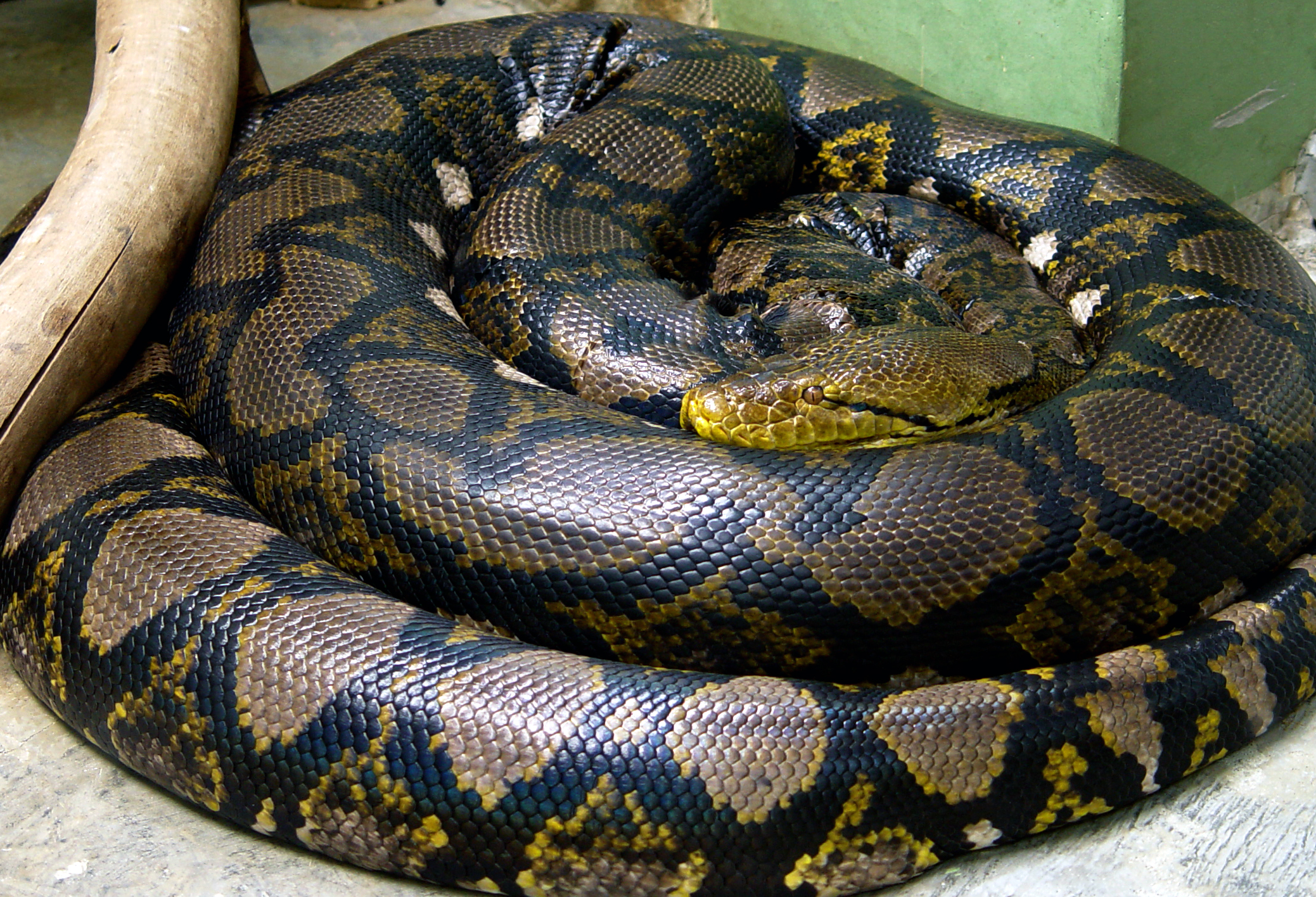
3. Burmese python (Python bivittatus)
The Burmese python (Python bivittatus) is a species of snake that is native to Southeast Asia, including parts of India, Bangladesh, Myanmar, Thailand, and Indonesia. Here are some additional details about this species:
Size : The Burmese python is one of the largest snake species in the world, with adult individuals reaching lengths of up to 23 feet (7 meters). However, most specimens are between 10 and 20 feet (3-6 meters) long.
Appearance : Burmese pythons are typically tan or brown in color, with dark blotches that run down the length of their bodies. They have a relatively slender build, with a large head and powerful jaws.
Diet : Burmese pythons are carnivorous and feed on a variety of prey, including rodents, birds, and other reptiles. They are capable of taking down large prey items, such as deer and wild pigs.
Habitat : Burmese pythons can be found in a variety of habitats, including rainforests, grasslands, and marshes. They are also sometimes found near human settlements.
Behavior : Burmese pythons are generally solitary animals, although they may gather in groups during mating season. They are skilled climbers and swimmers, and may spend time in the water to hunt for prey.
Conservation status : The Burmese python is listed as a species of least concern by the International Union for Conservation of Nature (IUCN), although it is threatened by habitat loss and overhunting in some areas. In certain regions where they have been introduced, such as in southern Florida, they are considered an invasive species and are causing ecological harm.
Teeth : Burmese pythons (Python bivittatus) have a large number of teeth that are curved backwards, which are called "rear-facing teeth". These teeth are used to hold onto prey and prevent it from escaping the snake's jaws. The number of teeth in a Burmese python's mouth can vary depending on the size and age of the individual. Juvenile snakes typically have between 50 and 60 teeth, while adult snakes can have up to 100 or more teeth. The teeth are replaced regularly throughout the snake's life, with new teeth growing in to replace those that are lost or worn down. Like other snakes, Burmese pythons are able to unhinge their jaws to swallow prey whole. The snake's teeth help to guide the prey into its mouth, and then hold onto it as the snake uses its powerful muscles to move the prey down its throat. Once the prey is inside the snake's digestive system, the teeth are no longer necessary and will eventually fall out and be replaced by new teeth.

4. African rock python (Python sebae)
The African rock python (Python sebae) is a species of large, non-venomous snake found throughout sub-Saharan Africa. Here are some details about this species:
Physical Characteristics:
- The African rock python is one of the largest snakes in the world, with adult males reaching lengths of up to 6 meters (20 feet) and females up to 4.5 meters (15 feet).
- They have a thick, muscular body and a broad, triangular head with small, sharp teeth.
- Their skin is typically colored in shades of brown, olive, or black, with light, irregular markings.
- They have heat-sensing pits on their lips that allow them to detect the body heat of prey.
Habitat and Distribution:
- African rock pythons are found throughout sub-Saharan Africa, from Senegal to Ethiopia and down to South Africa.
- They prefer habitats near water, such as swamps, marshes, and rivers, but can also be found in savannas and forests.
Behavior:
- African rock pythons are primarily nocturnal and spend most of the day hiding in burrows or under cover.
- They are ambush predators and will lie in wait for prey to come within striking distance.
- Their diet includes a wide range of animals, from rodents and birds to antelopes and crocodiles.
- During the breeding season, male pythons will fight for the right to mate with a female.
- African rock pythons are oviparous, meaning they lay eggs, and can lay up to 60 eggs in a clutch.
Conservation Status:
- African rock pythons are listed as a species of least concern by the IUCN Red List, although they face threats such as habitat loss and hunting for their skin and meat.
- They are also sometimes killed by humans in retaliation for preying on livestock or pets.
Location:
The African rock python (Python sebae) is found throughout sub-Saharan Africa, from Senegal to Ethiopia and down to South Africa. They are a widely distributed species and can be found in a variety of habitats, including savannas, forests, swamps, and marshes. African rock pythons prefer areas near water, such as riverbanks and wetlands, where prey is more abundant. They are adaptable to a range of environmental conditions and can even thrive in areas that have been modified by human activities, such as agricultural fields and suburban areas. However, they may be threatened by habitat loss due to human development and fragmentation of their natural habitats.
5. Amethystine python (Morelia amethistina)
The amethystine python (Morelia amethistina), also known as the scrub python or the giant python, is a species of python found in the northern regions of Australia, New Guinea, and some neighboring islands. Here are some details about this species:
Physical Characteristics:
- The amethystine python is one of the largest species of snake in the world, with some individuals reaching lengths of up to 8.5 meters (28 feet).
- They have a slender body and a small head with heat-sensing pits on their upper and lower jaws.
- Their skin is typically colored in shades of brown or gray, with irregular markings that can range from light tan to deep black.
Teeth:
- The amethystine python (Morelia amethistina) has long, recurved teeth that are used for grasping and holding onto prey. Like other snakes, they do not have chewing teeth, and instead swallow their prey whole. The teeth are located along the upper jaw and can number up to 100.
- The teeth are not venomous, but the python can deliver a powerful bite that can cause significant injury to humans if they feel threatened or are cornered. However, these snakes are generally shy and will usually retreat if given the opportunity to do so.
- The teeth of the amethystine python are adapted for hunting and consuming a wide variety of prey, including mammals, birds, and reptiles.
Habitat and Distribution:
- Amethystine pythons are found in the northern regions of Australia, New Guinea, and some neighboring islands.
- They prefer habitats near water, such as rainforests, wetlands, and riverbanks, but can also be found in drier areas such as savannas and scrublands.
Behavior:
- Amethystine pythons are primarily nocturnal and spend most of the day hiding in burrows, crevices, or under cover.
- They are ambush predators and will lie in wait for prey to come within striking distance.
- Their diet includes a wide range of animals, from rodents and birds to larger mammals such as wallabies and wild pigs.
- During the breeding season, male pythons will fight for the right to mate with a female.
- Amethystine pythons are oviparous, meaning they lay eggs, and can lay up to 50 eggs in a clutch.
Conservation Status:
- Amethystine pythons are listed as a species of least concern by the IUCN Red List, although they face threats such as habitat loss, hunting for their skin, and persecution by humans who consider them a threat to livestock or pets.
Location:
The amethystine python (Morelia amethistina) is native to northern Australia, New Guinea, and some neighboring islands. They can be found in a variety of habitats, including rainforests, wetlands, savannas, and scrublands. In Australia, they are found primarily in the tropical and subtropical regions of the Northern Territory and Queensland, although they have also been recorded in Western Australia and New South Wales. In New Guinea, they are found throughout the island, as well as on nearby islands in the surrounding seas. The amethystine python is a wide-ranging species and can tolerate a range of environmental conditions, although they prefer habitats near water, such as riverbanks and wetlands, where prey is more abundant.
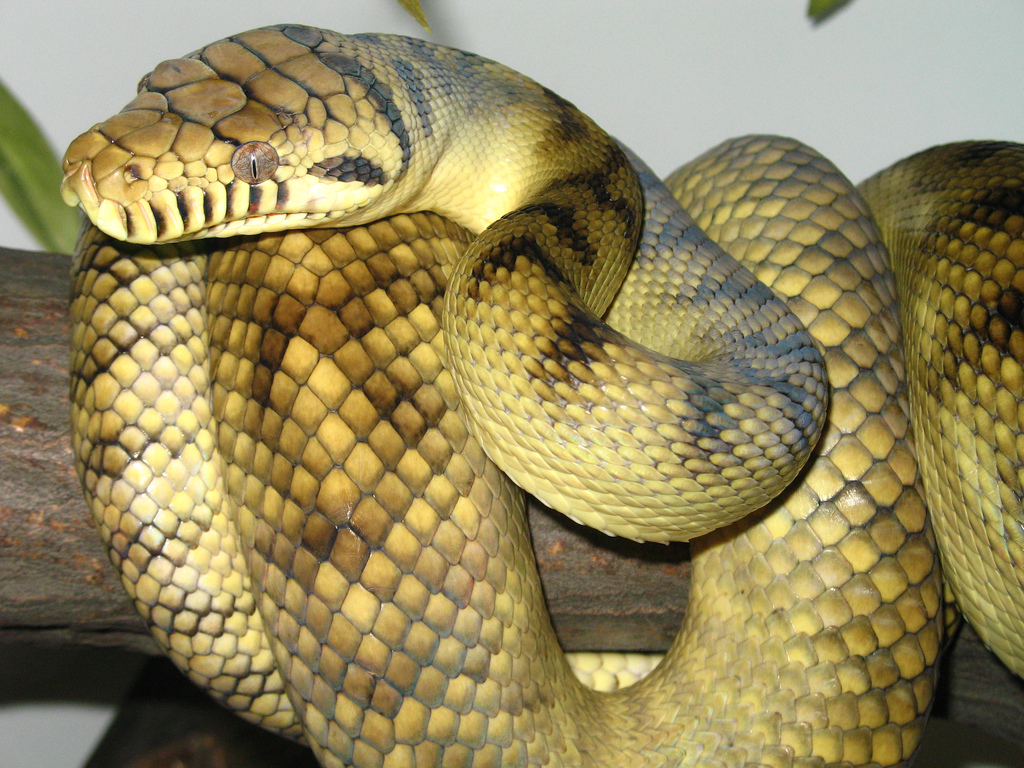
6. Indian python (Python molurus)
The Indian python (Python molurus) is a species of large, non-venomous snake native to the Indian subcontinent and surrounding areas. Here are some details about this species:
Appearance:
- The Indian python is one of the largest species of snake in the world, with adults typically growing between 3 and 6 meters (10 to 20 feet) in length.
- Their coloration can vary depending on their habitat, but generally they have a light beige or brown background color with darker brown or black blotches and spots.
- They have a broad, triangular head, and their scales are smooth and shiny.
Teeth:
- The Indian python (Python molurus) has numerous sharp, recurved teeth in its mouth. These teeth are designed for holding and grasping prey, rather than chewing it.
- The teeth of Indian pythons are curved backwards, allowing them to sink into their prey and hold onto it while they constrict it. These teeth are not venomous, but their powerful bite can cause significant damage to prey or potential threats.
- The teeth of Indian pythons are replaced throughout their life, as they wear down or fall out. Like other snakes, Indian pythons have multiple rows of teeth, and as the front teeth wear down, new teeth move forward to replace them.
- Indian pythons, like all snakes, do not have true chewing ability, and so they swallow their prey whole after killing it. Their teeth are important for holding and subduing prey, but not for tearing or chewing it into smaller pieces.
Habitat and distribution:
- Indian pythons are found throughout the Indian subcontinent and surrounding areas, including Pakistan, Nepal, Bhutan, Bangladesh, and Sri Lanka.
- They prefer to live in areas with dense vegetation and a permanent source of water, such as swamps, marshes, and riverbanks.
Behavior and diet:
- Indian pythons are nocturnal and spend most of their day hidden in vegetation or burrows.
- They are excellent swimmers and climbers and are known to be able to climb trees and swim across large bodies of water.
- Their diet consists mainly of mammals, including rodents, deer, and wild boar, although they have also been known to eat birds, reptiles, and even other snakes.
- They are constrictors, which means they kill their prey by coiling around them and squeezing until they suffocate.
Conservation status:
- Indian pythons are listed as "Vulnerable" by the International Union for Conservation of Nature (IUCN) due to habitat loss and hunting for their skins and meat.
- They are protected by law in many countries throughout their range, but their populations continue to decline in some areas.
Location:
The Indian python (Python molurus) is native to the Indian subcontinent and surrounding regions. Its range includes India, Pakistan, Nepal, Bhutan, Bangladesh, and Sri Lanka. Within this range, the Indian python is found in a variety of habitats, including grasslands, swamps, forests, and riverbanks.
In India, Indian pythons are found throughout the country, with the exception of the northeast and some parts of the Himalayas. They are particularly common in the Western Ghats, a mountain range along the west coast of India, and the Sunderbans, a mangrove forest in the delta of the Ganges, Brahmaputra, and Meghna rivers.
In Pakistan, Indian pythons are found in the Punjab, Sindh, and Balochistan provinces. In Nepal, they are found in the Terai region along the southern border with India. In Bhutan, they are found in the southern lowlands. In Bangladesh, they are found in the Sundarbans and other mangrove forests along the coast. In Sri Lanka, they are found in forests and agricultural areas in the northern and eastern parts of the island.
7. Scrub python (Morelia kinghorni)
The scrub python (Morelia kinghorni), also known as the Kinghorn's python, is a species of non-venomous snake found in northeastern Australia. Here are some details about this species:
Appearance:
- The scrub python is one of the largest species of snake in Australia, with adults reaching lengths of up to 8 meters (26 feet).
- They have a light brown to olive green background color, with irregular dark brown or black patches on their back and sides.
- The scales on their back are smooth and shiny, and their head is elongated and narrow, with a pointed snout.
Teeth:
- The scrub python (Morelia kinghorni) has numerous sharp, recurved teeth in its mouth. These teeth are designed for holding and grasping prey, rather than chewing it.
- The teeth of scrub pythons are curved backwards, allowing them to sink into their prey and hold onto it while they constrict it. These teeth are not venomous, but their powerful bite can cause significant damage to prey or potential threats.
- The teeth of scrub pythons are replaced throughout their life, as they wear down or fall out. Like other snakes, scrub pythons have multiple rows of teeth, and as the front teeth wear down, new teeth move forward to replace them.
- Scrub pythons, like all snakes, do not have true chewing ability, and so they swallow their prey whole after killing it. Their teeth are important for holding and subduing prey, but not for tearing or chewing it into smaller pieces.
Habitat and distribution:
- The scrub python is found in northeastern Australia, including Queensland and the Northern Territory.
- They inhabit a variety of habitats, including rainforests, woodlands, and swamps, and are often found near water sources.
Behavior and diet:
- The scrub python is primarily nocturnal and spends much of its day resting in trees or hiding in vegetation.
- They are excellent climbers and swimmers, and are known to hunt both on the ground and in trees.
- Their diet consists mainly of mammals, including rats, possums, and wallabies, as well as birds and reptiles.
- They are constrictors, which means they kill their prey by coiling around them and squeezing until they suffocate.
Conservation status:
- The scrub python is not currently listed as endangered or threatened, although habitat loss and hunting for their skin and meat have impacted some populations.
- They are protected by law in many areas of Australia, and efforts are being made to conserve their habitat and populations.
Location:
The scrub python (Morelia kinghorni) is found in northeastern Australia, including the states of Queensland and the Northern Territory. They inhabit a range of habitats, including rainforests, woodlands, and swamps, and are often found near water sources.
Within their range, scrub pythons are distributed across a wide area, from the Atherton Tableland in the north to the New South Wales border in the south. They are also found on several islands off the coast of Queensland, including Hinchinbrook Island and Magnetic Island.
Scrub pythons are one of the largest species of snake in Australia, and their large size and impressive appearance have made them a popular attraction for wildlife enthusiasts and tourists in the region. However, they are also known to cause conflict with humans, particularly when they are found in residential areas or near livestock. As a result, efforts are being made to educate the public about these snakes and to promote peaceful coexistence between humans and wildlife.
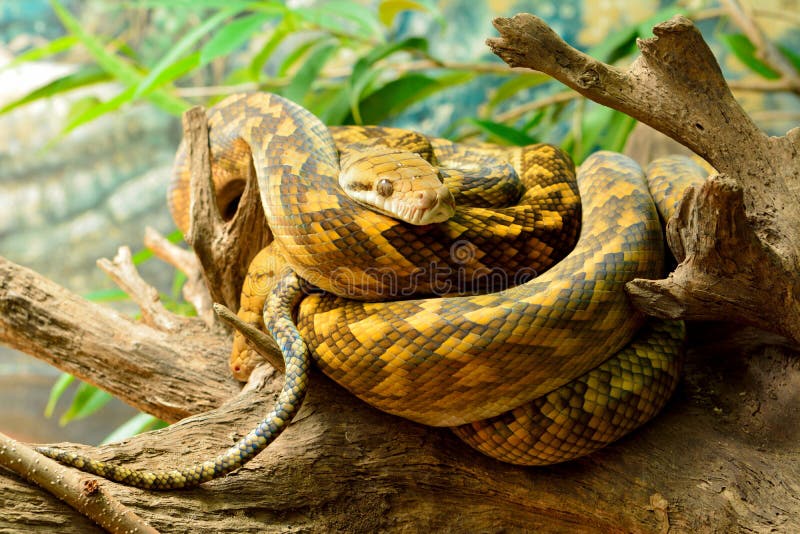
8. King cobra (Ophiophagus hannah)
The king cobra (Ophiophagus hannah) is a highly venomous snake that is native to Southeast Asia. Here are some details about this species:
Appearance:
- The king cobra is one of the largest venomous snakes in the world, with adults reaching lengths of up to 5.5 meters (18 feet).
- They have a distinctive appearance, with a large, flattened head and long, slender body.
- The scales on their back are usually a solid shade of brown or black, and they have a characteristic "hood" that they can flare when threatened.
Habitat and distribution:
- The king cobra is found in a range of habitats, including rainforests, grasslands, and swamps, throughout Southeast Asia.
- Their range includes countries such as India, Bangladesh, Bhutan, Nepal, Myanmar, Thailand, Cambodia, Laos, Vietnam, Malaysia, Indonesia, and the Philippines.
Behavior and diet:
- The king cobra is primarily diurnal and spends much of its day basking in the sun or hunting for prey.
- They are excellent climbers and swimmers, and are known to hunt both on the ground and in trees.
- Their diet consists mainly of other snakes, including venomous species such as cobras and kraits, as well as rodents, birds, and other small mammals.
- They are one of the few species of snake that are known to build nests for their eggs and to provide parental care for their young.
Teeth:
The king cobra (Ophiophagus hannah) has a pair of highly specialized, hollow fangs in the front of its upper jaw that are used to inject venom into its prey or potential threats. These fangs can grow up to 1.8 centimeters (0.7 inches) in length and are capable of delivering a large amount of venom in a single bite.
The fangs of a king cobra are located towards the front of its mouth, and are folded back against the roof of the mouth when not in use. When the snake strikes, the fangs rotate forward and the venom is injected into the target through a small hole near the tip of the fangs.
The venom of a king cobra is highly toxic, and can cause paralysis, respiratory failure, and death in humans if not treated promptly. However, king cobras are generally shy and will try to avoid humans if possible.
Venom and danger to humans:
- The venom of the king cobra is highly toxic and can cause paralysis or death in humans.
- Despite their fearsome reputation, king cobras are generally shy and will try to avoid humans if possible. However, they can become aggressive if they feel threatened or cornered, and bites from king cobras can be fatal if not treated promptly.
Conservation status:
- The king cobra is listed as a species of "least concern" by the International Union for Conservation of Nature (IUCN), due to its wide distribution and apparently stable population. However, habitat loss and hunting for their skin and meat have impacted some populations, and efforts are being made to conserve their habitat and populations.
Location:
The King Cobra (Ophiophagus hannah) is found in South and Southeast Asia, including India, Sri Lanka, Bangladesh, Myanmar, Thailand, Cambodia, Vietnam, Laos, Malaysia, Indonesia, and the Philippines. They typically inhabit forests, grasslands, and mangrove swamps, and are known to be excellent swimmers.
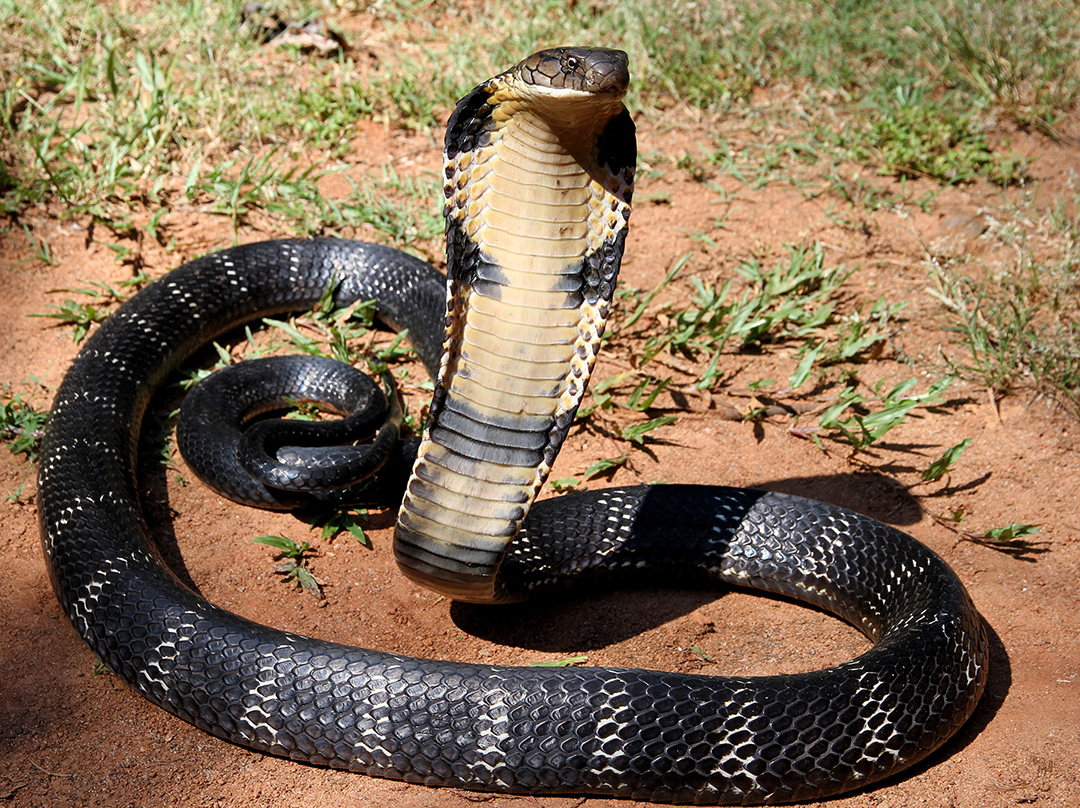
9. Bushmaster (Lachesis muta)
The Bushmaster (Lachesis muta) is a venomous pit viper species found in Central and South America, ranging from southern Mexico to northern South America. It is one of the largest venomous snakes in the world, with adults reaching lengths of up to 3 meters (10 feet).
Here are some additional details about the Bushmaster:
Habitat: The Bushmaster can be found in a variety of habitats, including rainforests, swamps, and lowland forests. It is primarily a ground-dwelling snake but can also climb trees and swim.
Appearance: The Bushmaster has a triangular-shaped head and a thick body. It is typically brown or gray in color with dark, diamond-shaped markings along its body.
Diet: The Bushmaster primarily feeds on rodents, but it has also been known to eat birds and other snakes.
Venom: The Bushmaster's venom is highly toxic and can cause significant tissue damage, internal bleeding, and neurological symptoms. However, the snake is generally not aggressive and will usually only attack if provoked or threatened.
Conservation status: The Bushmaster is listed as "Least Concern" by the International Union for Conservation of Nature (IUCN), which means that it is not currently at risk of extinction. However, habitat destruction and hunting for its skin and meat are threats to its population in some areas.
Teeth: The Bushmaster (Lachesis muta) has two long, hollow fangs in the front of its upper jaw that can measure up to 4 centimeters (1.6 inches) in length. These fangs are used to inject venom into prey or defensive threats. In addition to the fangs, the Bushmaster has several rows of smaller teeth located in the upper and lower jaws. These teeth are not used to inject venom but rather to grip and hold onto prey. The Bushmaster's fangs are replaced periodically throughout its life as they wear down or are lost due to use or damage.
Location:
The Bushmaster (Lachesis muta) is found in Central and South America, ranging from southern Mexico to northern South America. Its range includes countries such as Belize, Guatemala, Honduras, Nicaragua, Costa Rica, Panama, Colombia, Ecuador, Peru, Brazil, and Bolivia. The snake is primarily found in tropical rainforests, but it can also be found in swamps and other moist habitats. It is a secretive and elusive species that is often difficult to spot in the wild.
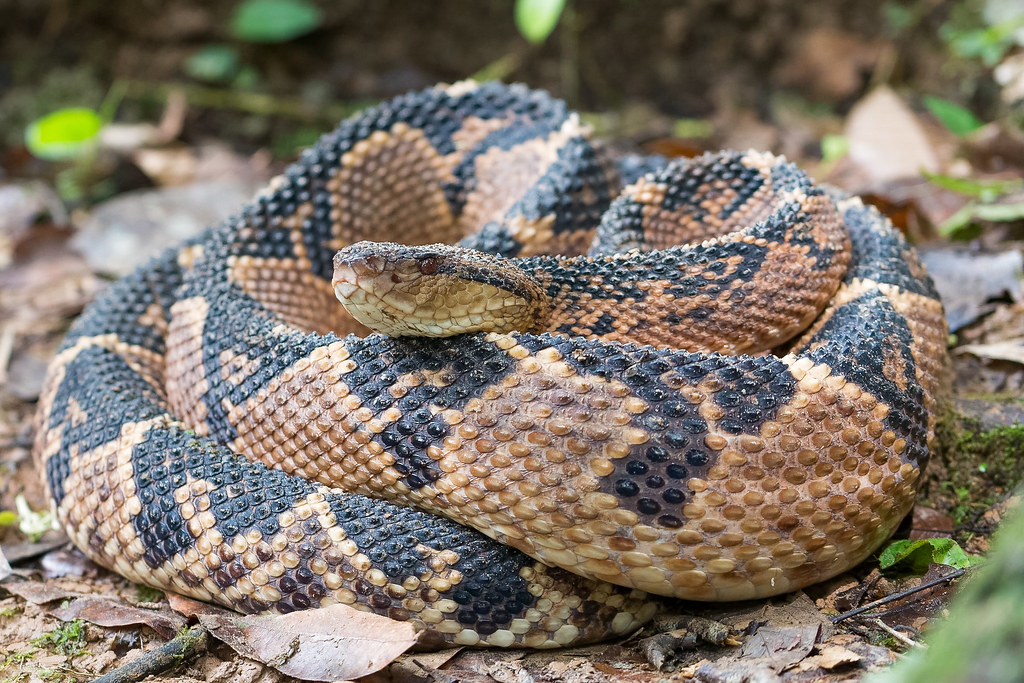
10. Diamondback rattlesnake (Crotalus adamanteus)
The Diamondback Rattlesnake (Crotalus adamanteus) is a venomous pit viper species found in the southeastern United States, primarily in Florida, Georgia, and the Carolinas. Here are some details about the species:
Appearance: The Diamondback Rattlesnake is named for the diamond-shaped pattern on its back, which is made up of dark brown or black scales outlined in white or light gray. The snake can grow up to 2.4 meters (8 feet) long, making it one of the largest rattlesnake species in the world. It has a distinctive triangular head, vertical pupils, and long, hollow fangs.
Habitat: The Diamondback Rattlesnake can be found in a variety of habitats, including forests, swamps, and deserts. It is particularly fond of dry, rocky areas with lots of vegetation for cover.
Diet: The Diamondback Rattlesnake feeds primarily on rodents, but it will also eat birds, lizards, and other snakes. The snake uses its heat-sensing pits to detect prey, and then strikes with its fangs, injecting venom that immobilizes the prey.
Venom: The Diamondback Rattlesnake's venom is highly toxic and can cause severe pain, swelling, and tissue damage. In some cases, the venom can be fatal to humans if not treated promptly.
Behavior: The Diamondback Rattlesnake is generally a solitary and secretive species, but it can become aggressive if threatened or cornered. The snake uses its rattle as a warning signal, shaking its tail rapidly to produce a distinctive buzzing sound. If the warning is ignored, the snake may strike.
Conservation status: The Diamondback Rattlesnake is not currently considered to be at risk of extinction. However, habitat loss and hunting for its skin and meat are potential threats to its populations in some areas.
Teeth: The Diamondback Rattlesnake (Crotalus adamanteus) has two long, curved, and hinged fangs located in the front of its upper jaw. These fangs can grow up to 2.5 centimeters (1 inch) in length and are used to inject venom into prey or defensive threats. When the snake strikes, the fangs rotate downward and forward to penetrate the target, and venom is then delivered through a duct in the center of each fang. The Diamondback Rattlesnake's fangs are replaced periodically throughout its life as they wear down or are lost due to use or damage. In addition to the fangs, the snake has several rows of smaller teeth located in the upper and lower jaws, which are used to grip and hold onto prey.
Location:
The Diamondback Rattlesnake (Crotalus adamanteus) is found in the southeastern United States, primarily in Florida, Georgia, and the Carolinas. The species has a wide range and can also be found in parts of Alabama, Mississippi, Louisiana, Texas, Arkansas, Oklahoma, and Kansas. The snake prefers dry, rocky areas with lots of vegetation for cover, but it can also be found in a variety of other habitats, including forests, swamps, and deserts.
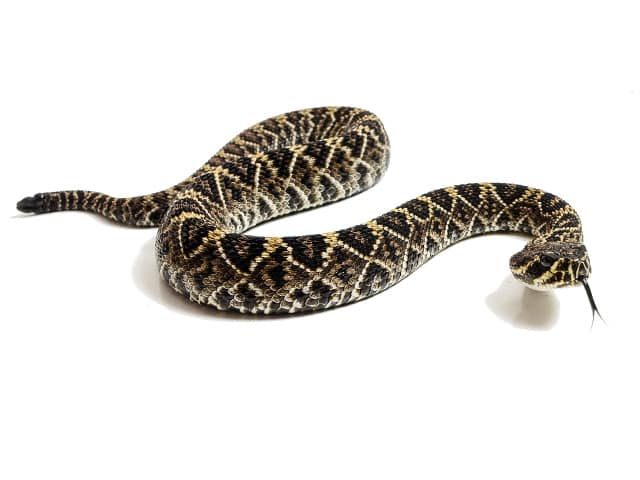
Blog Upload on - March 2, 2023
Views - 4144

posted By -
Animals Super Store
Related Posts
-
Top Natural Foods for Dogs
Oct. 21, 2022 -
Gaushala In Uttar Pradesh
Aug. 14, 2022 -
Healthy Habits For Animals
Oct. 26, 2023 -
 DELHI BIRD & ANIMAL HELPLINE
DELHI BIRD & ANIMAL HELPLINE
Aug. 27, 2022 -
 Top 10 Longest And Heaviest Crocodiles
Top 10 Longest And Heaviest Crocodiles
March 1, 2023 -
Top 10 Smartest Dog Breeds
March 15, 2023 -
What are Sacrificial Rituals
April 20, 2022 -
 Black Mamba
Black Mamba
April 14, 2023



